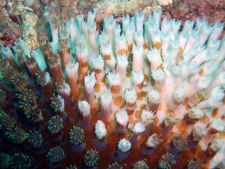|
Contact the seller in advance before paying for the order! Coral – Part 2 – Damaging Desire
After its fall from grace in the late Victorian ages, this beautiful gem is again treasured for jewelry. But there is a price to pay for their beauty. As mentioned earlier in part one, these amazing organisms are important to marine ecosystems. They are however very sensitive to environmental changes, like temperature, ocean acidification and pollution as well as over harvesting for jewelry and home decor.
The reefs have begun to die, due to our thoughtlessness. According to a study World Rescue Institute did in 1998, as much as 58% of the worlds reefs is at risk, and may be permanent damaged by human activity. Marine biologists shout warnings and work for ways to protect the reefs, before the damage is irreparable. The demand for this beautiful gem have brought populations to near extinction. The harvesting are sometimes done in quite brutal ways, by dredging nets along the sea bottom, damaging not only coral, but other marine organisms as well. Some places this way of harvesting is now forbidden, and other less damaging methods are used, like scuba diving. Some species like Antipathes and Gerardia is put on CITES (convention on international trade in endangered species) list of endangered organisms along with 2000 other species of the gem, and are protected by law. Corallium Rubrum, Secunda and Leipidisis Olapa are however not. The Antipathes trade is estimated at 5 metric tons, while Corallium rubrum and Secunda are 30-50 tons, running dangerously low on further supply. Protective measurement for these three species was overturned in 2007, due to pressure from the jewelry industry dealing with the gem. Some jewelry companies do see the importance in protecting the reefs, though. Tiffany have removed the species from its products list and actively encourages other jewelry companies to do the same. Several have followed them on this, and substitues are made instead of using the real gem. 158 countries have signed a convention that makes it illegal to import the gem into these countries. Among them are USA, UK, EU, Canada and Australia. Some countries have as well legislations regarding the collection and export of it. In some countries the gem is totally banned altogether. If you want to buy it, you must make sure that what you buy is legal. You should ask the store or seller for information about the jewelry in question and where the gems are from. You may need a CITES export permit to be able to take it with you home. Make sure you have one before you buy the jewelry. What can YOU do?: However, seeing the impact our desires have on our ecosystems, should be a red herring to be taken serious. When it comes to these beautiful organisms, there are a few things you can do to help preserve the reefs we still have left.
Like with fur, buy fake. Nobody suffers, get killed, destroyed or damaged, but you get the looks. With today's technology you can hardly tell the different between fake and real. So, make a statement – say no to coral jewelry. Return to It's All About Jewelry Beads Leave a comment ,I would love to hear your opinion on this page. Good or bad, it will help me making this Site better. |


